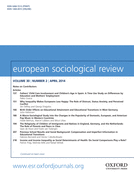-
Views
-
Cite
Cite
Mathieu Ichou, Grace Kao, Elizabeth Vaquera, and Kimberly Goyette: Education and Immigration, European Sociological Review, Volume 30, Issue 2, April 2014, Pages 271–273, https://doi.org/10.1093/esr/jcu041
Close - Share Icon Share
Extract
Children of immigrants account for almost a quarter of the school-aged population in the United States, and this proportion is expected to rise to two in five by 2020 (p. 7). In this context, Kao, Vaquera, and Goyette provide a welcome account of research findings on the links between immigration and education in the United States. To be clear, the goal of their book is not to produce original results, but rather to review existing ones. This objective is achieved with flying colors: in a little more than 200 pages, Education and Immigration covers state-of-the-art knowledge in this field in a clear and structured way that will appeal to students, researchers, and interested readers on both sides of the Atlantic.
In the introductory first chapter, the three authors justify the need for the historical and sociological inquiry of the educational outcomes of immigrants and their children in the United States, a country that is often presented as both a society of immigrants and a land of opportunity where it is believed that even newcomers can achieve success through education. Education is especially important in immigrant families, as it is ‘an indicator of assimilation and a precursor to upward mobility’ (p. 23). The book focuses mostly on post-1965 immigrants, who overwhelmingly come from Latin America and Asia, in contrast to older immigrants who mostly arrived from Europe.



